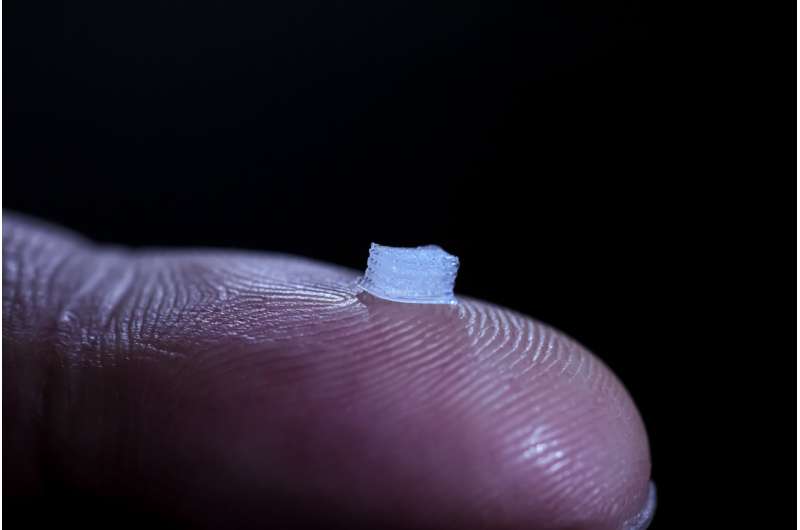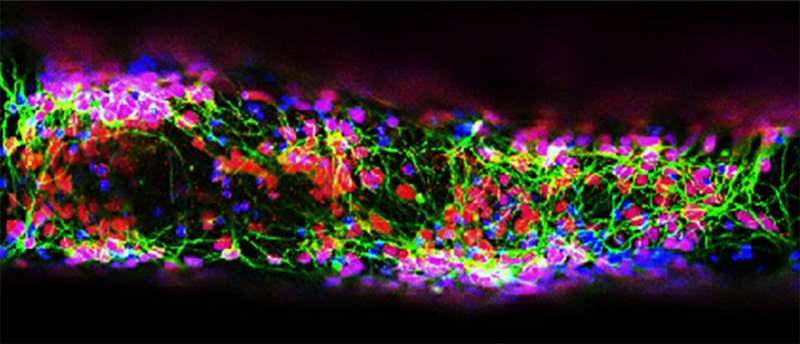New 3D-printed device could help treat spinal cord injuries

Engineers and medical researchers at the University of Minnesota have teamed up to create a groundbreaking 3-D-printed device that could someday help patients with long-term spinal cord injuries regain some function.
A 3-D-printed guide, made of silicone, serves as a platform for specialized cells that are then 3-D printed on top of it. The guide would be surgically implanted into the injured area of the spinal cord where it would serve as a type of "bridge" between living nerve cells above and below the area of injury. The hope is that this would help patients alleviate pain as well as regain some functions like control of muscles, bowel and bladder.
The research is published online today in Advanced Functional Materials, a peer-reviewed scientific journal.
"This is the first time anyone has been able to directly 3-D print neuronal stem cells derived from adult human cells on a 3-D-printed guide and have the cells differentiate into active nerve cells in the lab," said Michael McAlpine, Ph.D., a co-author of the study and University of Minnesota Benjamin Mayhugh Associate Professor of Mechanical Engineering in the University's College of Science and Engineering.
"This is a very exciting first step in developing a treatment to help people with spinal cord injuries," said Ann Parr, M.D., Ph.D., a co-author of the study and University of Minnesota Medical School Assistant Professor in the Department of Neurosurgery and Stem Cell Institute. "Currently, there aren't any good, precise treatments for those with long-term spinal cord injuries."
There are currently about 285,000 people in the United States who suffer from spinal cord injuries, with about 17,000 new spinal cord injuries nationwide each year.
In this new process developed at the University of Minnesota over the last two years, researchers start with any kind of cell from an adult, such as a skin cell or blood cell. Using new bioengineering techniques, the medical researchers are able to reprogram the cells into neuronal stem cells. The engineers print these cells onto a silicone guide using a unique 3-D-printing technology in which the same 3-D printer is used to print both the guide and the cells. The guide keeps the cells alive and allows them to change into neurons. The team developed a prototype guide that would be surgically implanted into the damaged part of the spinal cord and help connect living cells on each side of the injury.
"Everything came together at the right time," Parr said. "We were able to use the latest cell bioengineering techniques developed in just the last few years and combine that with cutting-edge 3-D-printing techniques."
Even with the latest technology, developing the prototype guides wasn't easy.

"3-D printing such delicate cells was very difficult," McAlpine said. "The hard part is keeping the cells happy and alive. We tested several different recipes in the printing process. The fact that we were able to keep about 75 percent of the cells alive during the 3-D-printing process and then have them turn into healthy neurons is pretty amazing."
If the next steps are successful, the payoff for this research could be life-changing for those who suffer from spinal cord injuries.
"We've found that relaying any signals across the injury could improve functions for the patients," Parr said. "There's a perception that people with spinal cord injuries will only be happy if they can walk again. In reality, most want simple things like bladder control or to be able to stop uncontrollable movements of their legs. These simple improvements in function could greatly improve their lives."
More information: Daeha Joung et al, 3D Printed Stem-Cell Derived Neural Progenitors Generate Spinal Cord Scaffolds, Advanced Functional Materials (2018). DOI: 10.1002/adfm.201801850














